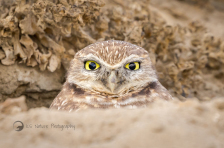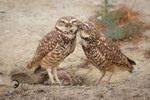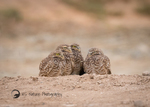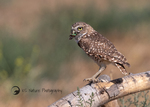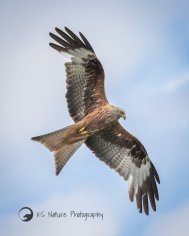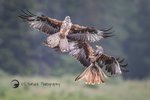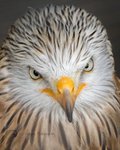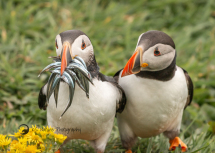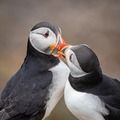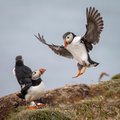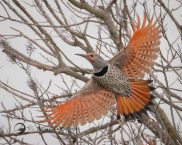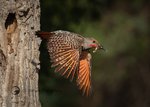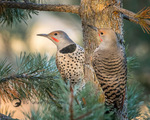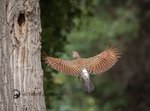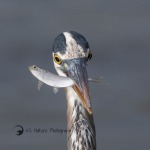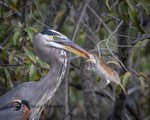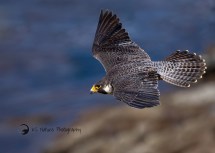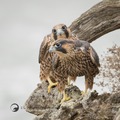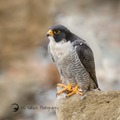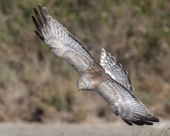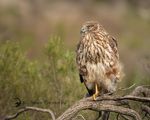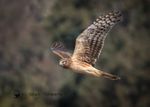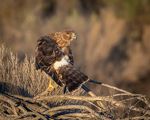Bird of the Month
I would like to introduce you to my new series where I will feature a specific bird each month and share some photos and info
about them. Enjoy and please follow me on Facebook for even more fun posts and photos, the latest from my favorite spot, Lake Hodges and all the news from my travels, tours, workshops and more.
Cheers~
Bird of the Month - Burrowing Owl
While we generally picture owls living in trees, burrowing owls live underground. True recyclers, burrowing owls often take over burrows abandoned by
badgers, prairie dogs, ground squirrels, and even tortoises.
These owls are most active during the day, hunting for insects and small mammals on the ground. The best times to spot a burrowing owl is early in the
morning and late in the evening, which is coincidentally also the best time to catch insects.
Like many burrowing animals, burrowing owls hoard food to get them through lean times; and they take this job seriously. A Saskatchewan cache observed
in 1997 contained more than 200 rodents.
These cute little birds also have a significant tolerance carbon dioxide. Since burrowing owls spend a significant amount of time together deep in their
burrows without access to fresh airflow, this adaptation allows them to safely live underground where oxygenated air is not readily available, and gas levels often accumulate to higher
levels.
And as always, if you do see owls and nests, please do not share their location. Enjoy and remember to observe and photograph them safely and
ethically.
Bird of the Month - Red Kite
The Red Kite is a medium-large bird of prey in the family Accipitridae, which also includes many other raptors such as
eagles, buzzards, and harriers. Kites hunt on the wing, soaring and circling over open ground. They are mainly carrion eaters, but are quite capable of killing small mammals and birds.
The wingspan of Red Kites can reach up to 170 cm (67 in). Considering this large wingspan, the kites are very light birds,
weighing no more than 0.9-1.3 kg (1.9-2.8lbs). The lifespan of Red Kites is usually around 4-5 years, but they can grow as old as 26 years of age.
The Red Kites became extinct as a Scottish breeding bird species in the late nineteenth century, primarily due to human
persecution by sporting estates, the taxidermy trade and egg collecting. Between 1989 and 1994, 93 red kites were reintroduced on the Black Isle and it was followed by a second reintroduction of 103
birds at Argaty, near Doune. Big success on this conservation project and it is with the RSPB's help that they are providing a facility for enjoying the birds in comfort but without the risk of
disturbing what is still a fragile population. During my Scotland tours we get to photograph these amazing birds, their vocalization is as amazing as their flight.
Bird of the Month - Atlantic Puffin
Oh oh oh these cute little Puffins, and I just had to include a few extra photos of my favorite little birdies. Also there are only 2 days left to vote for my photo in the Comedy Wildlife Photography Awards. Please CLICK HERE to vote (by October 11 2020).
Let's dive right into it. Atlantic Puffins spend most of their life at sea and they only come on land in the
spring mating season. They don't build nests, they dig burrows. The female will lay ONE egg only and they raise one chick in a year called the Puffling. Oh cute name eh? Rolly-polly little chick gets
fed all those sand eels you see in my photo. Puffins mate for life. Some puffin pairs known to been together for 20 years. The
love! "Puffins’ beaks are known for their technicolor orange hue, but just before winter the birds shed the outer layer of their bills, leaving them smaller
and duller. When spring arrives, though, their beaks return to their bright form, just in time for mating season."
"They are excellent flyers and dive for fish with some speed! Despite their stout bodies and short wings, puffins can fly as fast as 55 mph, but not
without some serious effort: they do flap their wings 300 to 400 times per minute to stay aloft. They are excellent swimmers that use their wings to stroke underwater with a flying motion. They steer
with rudder like webbed feet and can dive to depths of 200 feet, though they usually stay underwater for only 20 or 30 seconds. Puffins typically hunt small fish like herring or sand
eels."
And to photograph these cuties, well, you will want to come with me on my Scotland
tours!
I hope you enjoyed the info, the photos and please remember to vote for my photo in the Comedy Wildlife Photography Awards. The Puffins thank you and so do I.
Bird of the Month - Northern Flicker
OHHH those amazing colors! Well, I just couldn't wait any longer to share this amazing bird with you. (Also I have a super
busy weekend coming up with multiple clients out on Lake Hodges.) So here is a bird that you will likely hear first, before you see. And a little tip before you venture out to find and to photograph
them: learn their sound! I can pick out their sound from anywhere.
"The Northern flicker is a very colorful woodpecker, especially in flight, native to most of North America and parts of
Central America. Their food is mostly ants, other insects, berries too. Adult birds are brown in color with black bars on the back and wings. They are cavity nesters and mate for life. They prefer to
excavate their own home, although they also reuse and repair damaged or abandoned nests. Both the male and the female help with nest excavation that can take 1 to 2 weeks to complete." This year I
was lucky to observe this process near by at the Lake. Yes, we do have Northern Flickers at Lake Hodges! Read the full post HERE.
Bird of the Month - Great Blue Heron
So you may think he is "just" the Great Blue Heron, a very common bird. Well, here are a few cool shots to change your mind.
Really, you can even surf on a Great Blue Heron, especially if you are a Red-winged Blackbird.
The Great Blue Heron is the the largest and most widespread heron in North America. With a height between 3.7 and 4.5 feet
and a wingspan of up to 6.6 feet they only weigh about 4.0–7.0 lb. Their diet, as you can see, includes both red meat and fish.
Here are a few cool facts about them: "Great blue herons have specialized feathers on their chest that will grow
continuously and fray into a powder. The herons comb this “powder down” with a fringed claw on their middle toes, using the down like a washcloth to remove fish slime and other oils from their
feathers as they preen." CLICK HERE to read the full story and more fun facts!
Bird of the Month - Peregrine Falcon
When you see a Peregrine falcon, you are looking at the fastest animal on the planet. Peregrine falcons have been clocked at
reaching speeds of 242 miles per hour while diving for prey, making them the fastest recorded animal ever. To allow them to reach such mind-blowing speeds, these birds boast aerodynamic torsos and
specially pointed wings, as well as adapted cardiovascular and respiratory systems that allow them to beat their wings up to four times per second without fatiguing.
By the middle of the twentieth century, the peregrine falcon was placed on the Endangered Species List, due to a sharp
decline in its population. This decline was caused by DDT pesticide contamination, which caused their eggshells to be so thin that they would break when the adults tried to incubate them. In 1999,
due in part to bans on the usage of DDT, and breeding and reintroduction programs designed by falconers and raptor biologists, the peregrine was removed from the endangered species list. Here in San
Diego you can find them at many locations, Lake Hodges is one. There are also two breeding pairs in La Jolla CA area, most of my photos in this post are of those falcons. CLICK HERE to read the full story and a few fun facts!
Bird of the Month - The Northern Harrier
The Northern Harrier is is a slender, medium-sized raptor with a long, barred tail and distinctive white rump and it is the
only harrier in North America. Harriers have an owl-like facial disk that allows them to hunt by sound as well as by sight." Unlike most other hawks, it may rely on its keen hearing to help it locate
prey as it courses low over the fields. Their diet consists mostly of small mammals and birds.
Northern Harriers are one of the rare birds where the male and female are quite different in coloring and easily identified.
"Males are gray above and whitish below with black wingtips, a dark trailing edge to the wing, and a black-banded tail. Females and immatures are brown, with black bands on the tail. Adult females
have whitish undersides with brown streaks. All Northern Harriers have a white rump patch that is obvious in flight." And here are a few other facts for you:
• Northern Harriers are the only hawk-like birds where one male mates with several females.
• Nicknamed the “Gray Ghost”, the male Harrier is ..well..a ghost. Hard to find and harder to photograph.
• The Northern Harrier is capable of speeds up to 38 mph of sustained, horizontal speed in pursuit of prey.
• The common name, Harrier, is from the Old English word “herigan” which means to harass or plunder.
Enjoy! Cheers~~

